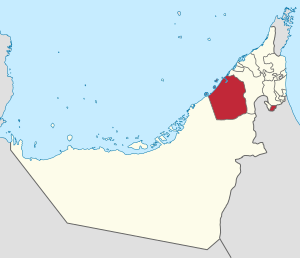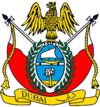Emirate of Dubai facts for kids
Quick facts for kids
Emirate of Dubai
دبيّ
Imārat Dubayy
|
|||
|---|---|---|---|
|
Emirate
|
|||
|
|||
 |
|||
| Country | |||
| Independence from the UK | 2 December 1971 | ||
| Seat | Dubai | ||
| Subdivisions |
9 Municipalities
Bur Dubai
Deira Jumeirah Jebel Ali Al Awir Ras Al Khor Mushraif Al Qudra Hatta |
||
| Government | |||
| • Type | Islamic absolute monarchy within a federation | ||
| Area | |||
| • Total | 4,114 km2 (1,588 sq mi) | ||
| Area rank | 2nd | ||
| Population
(2021)
|
|||
| • Total | 3,478,300 | ||
| • Rank | 1st | ||
| • Density | 1,015/km2 (2,630/sq mi) | ||
| Demonym(s) | Dubaian | ||
| Time zone | UTC+4 (UAE standard time) | ||
| • Summer (DST) | UTC+4 | ||
| ISO 3166 code | AE-DU | ||
| Nominal GDP | 2015 estimate | ||
| Total | US$105 billion | ||
| Per capita | US$44,000 | ||
| Religion | Islam (the official state religion of the UAE) | ||
The Emirate of Dubai (Arabic: إمارة دبيّ; pronounced Imārat Dubayy) is one of the seven emirates of the United Arab Emirates. It is the most populated emirate in the UAE. The main city of the emirate is also called Dubai.
Contents
Where is Dubai Located?
The city of Dubai sits right on the coast of the Persian Gulf. The wider Emirate of Dubai stretches further inland. To the south, it shares a border with the emirate of Abu Dhabi. To the northeast, it borders the emirate of Sharjah. The country of Oman is to its southeast. On the east, you'll find the emirate of Ajman, and to the north, the emirate of Ras Al Khaimah.
Main Towns and Areas
The Emirate of Dubai includes several important areas. These are often called municipalities or villages. The main ones are:
- Dubai (the big city)
- Jebel Ali
- Jumeirah
- Hatta
Hatta is a special part of Dubai. It's an exclave, meaning it's a piece of land that belongs to Dubai but isn't connected to the main part. Hatta is about 134 kilometers (83 miles) east of Dubai city. It's surrounded by Oman to the east and south. To the west, it borders villages in Ajman, and to the north, it borders Ras Al Khaimah.
A Look at Dubai's Past
In the early 1800s, the small coastal town of Dubai was part of the Bani Yas tribe's land. However, it was also close to the powerful Al Qasimi clan. This led to both groups trying to control the town.
The Pearl Trade Era
During the 1800s, pearls were the most important product in the region. Buyers from Mumbai came to trade. The pearl business was at its busiest around 1897.
In 1901, a leader named Maktoum bin Hasher Al Maktoum made a big change. He declared Dubai a free port. This meant there were no taxes on goods coming in or going out. He also gave land to merchants and promised them safety. These rules encouraged many traders to move to Dubai. They came from places like Lingeh and even from other emirates like Ras Al Khaimah and Sharjah.
Dubai quickly grew in importance. Shipping companies started making more and more visits. By 1906, Dubai had become the main trading center of the area. By 1908, about 10,000 people lived there.
Challenges and New Discoveries
By the 1930s and 1940s, the pearl business faced a big problem. Cultured pearls from Japan became popular and cheaper. This caused the pearl market to crash, leading to tough times and even a famine in Dubai.
Hope returned in 1937 when a contract was signed to look for oil. This agreement promised payments to Dubai's ruler, Sheikh Saeed bin Maktoum. However, because of World War II, oil wasn't found until 1966 at the Fateh Oil Field.
Forming the UAE
In December 1971, the emirates, including Dubai, joined together to form the United Arab Emirates. This marked the end of their time as British Protectorates.
The current ruler of the Emirate of Dubai is Sheikh Mohammed bin Rashid Al Maktoum.
Who Has Ruled Dubai?
Here is a list of the rulers of Dubai over the years:
- 1833 – 1836: Sheikh Obeid bin Said bin Rashid
- 1836 – 1852: Sheikh Maktoum bin Butti bin Suhail
- 1852 – 1859: Sheikh Saeed bin Butti
- 1859 – 1886: Sheikh Hasher bin Maktoum
- 1886 – 1894: Sheikh Rashid bin Maktoum
- 1894 – 1906: Sheikh Maktoum bin Hasher Al Maktoum
- 1906 – 1912: Sheikh Butti bin Suhail Al Maktoum
- 1912 – 1958: Sheikh Saeed bin Maktoum bin Hasher Al Maktoum
- 1958 – 1990: Sheikh Rashid bin Saeed Al Maktoum
- 1990 – 2006: Sheikh Maktoum bin Rashid Al Maktoum
- 2006 – Present: Sheikh Mohammed bin Rashid Al Maktoum
How Many People Live in Dubai?
| Historical population | ||
|---|---|---|
| Year | Pop. | ±% p.a. |
| 1953 | 50,000 | — |
| 1968 | 59,000 | +1.11% |
| 1980 | 276,301 | +13.73% |
| 1985 | 370,788 | +6.06% |
| 1995 | 689,420 | +6.40% |
| 2005 | 1,321,453 | +6.72% |
| 2010 | 1,837,610 | +6.82% |
| 2017 | 2,836,062 | +6.40% |
| Source: Citypopulation | ||
See also
 In Spanish: Dubái para niños
In Spanish: Dubái para niños
- Outline of Dubai
- Emirates of the United Arab Emirates



